The demand for brandy flavor in Japan is projected to grow from USD 196.8 million in 2025 to USD 268.4 million by 2035, reflecting a CAGR of 3.2%. Brandy flavoring is widely used in the beverages industry, especially for creating a distinct, rich taste profile in alcoholic drinks, cocktails, and flavored food products. Japan's growing interest in premium beverages, including cocktails and liqueurs, will drive the demand for brandy flavoring. Additionally, as consumer tastes evolve toward more complex flavors and authenticity, brandy flavoring will become an essential ingredient in crafting high-end products.
The market is also influenced by Japan's strong tradition of alcoholic drink innovation and the growing interest in mixology. As both alcoholic and non-alcoholic drink manufacturers increasingly experiment with premium and complex flavor profiles, brandy flavor will continue to see growth. Furthermore, the shift toward natural, high-quality ingredients in food and beverages will likely encourage the demand for genuine brandy flavor extracts and natural flavor formulations over synthetic alternatives.

From 2025 to 2030, the demand for brandy flavor in Japan will grow from USD 196.8 million to USD 229.9 million, contributing an increase of USD 33.1 million in value. This phase will experience a period of steady growth, with a gradual rise in demand as consumer preferences for premium, flavored beverages continue to expand. The peak of this growth period is likely to occur around 2027, when the demand for premium cocktails and craft beverages peaks. During this time, more consumers will seek novel flavor experiences, driving the adoption of brandy-based drinks and mixers in both the domestic and export markets.
From 2030 to 2035, the market will grow from USD 229.9 million to USD 268.4 million, adding USD 38.5 million in value. The growth during this phase will be slower, marking a maturation of the market, with the demand stabilizing and reaching its trough toward the middle of the period. This deceleration will likely occur as the market reaches saturation in terms of product offerings and consumer adoption. While the demand for brandy flavor will remain strong, the rate of expansion will moderate as the market matures, and growth will be supported primarily by brand innovation, new product launches, and continued interest in premium flavor options.
| Metric | Value |
|---|---|
| Industry Sales Value (2025) | USD 196.8 million |
| Industry Forecast Value (2035) | USD 268.4 million |
| Industry Forecast CAGR (2025 to 2035) | 3.2% |
Demand for brandy flavor in Japan is supported by its increased use in bakery, confectionery and beverage applications where premium spirit inspired notes appeal to consumer preferences. The market value in Japan is estimated at USD 196.8 million and projected to rise to USD 268.4 million by 2035, indicating a compound annual growth rate (CAGR) of around 3.2 %.
Further growth is contributed by manufacturers of syrup based beverages and ready to drink cocktails incorporating brandy flavor extracts to deliver aged spirit profiles in non alcoholic formats. At the same time, clean label trends and interest in natural and alcohol free flavoring agents encourage substitution of traditional extracts with flavor compounds suitable for mass market foods and drinks. Restrictions on alcohol derived flavor use in some food categories and higher costs of premium extracts act as constraints. Nonetheless, the combination of flavor innovation, alternative application channels and steady product demand positions the brandy flavor segment in Japan for moderate expansion.
The demand for brandy flavor in Japan is primarily driven by application and product type. The leading application is bakery & confectionery, which captures 29% of the market share, while grape brandy is the dominant product type, accounting for 34.1% of the demand. Brandy flavor, used to enhance the complexity and depth of taste, is gaining popularity in the Japanese food and beverage market, with applications ranging from baked goods to savory dishes. The preference for rich and sophisticated flavor profiles continues to drive the demand for brandy flavor in various culinary sectors.
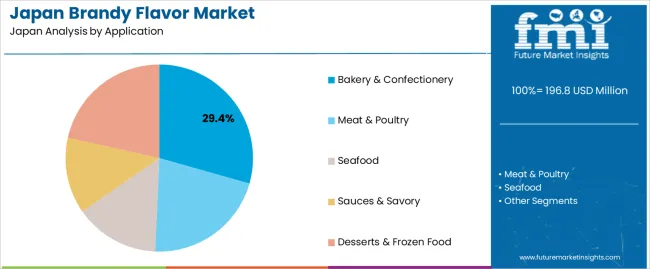
Bakery & confectionery is the leading application for brandy flavor in Japan, holding 29% of the market share. Brandy is commonly used to enhance the flavor of a variety of baked goods and sweets, including cakes, pastries, chocolates, and candies. The richness and aromatic profile of brandy flavor add a level of sophistication and complexity to both traditional and modern confections, making it a preferred ingredient in many bakeries and confectioneries.
The demand for brandy flavor in the bakery and confectionery industry is driven by the growing consumer preference for high-quality, premium ingredients that elevate the flavor profile of food products. With an increasing focus on unique, artisanal flavors in the Japanese market, the use of brandy flavor in sweets and baked goods offers manufacturers the opportunity to create distinctive offerings. As demand for innovative and gourmet products continues to rise, bakery and confectionery applications will remain a key segment for brandy flavor in Japan.
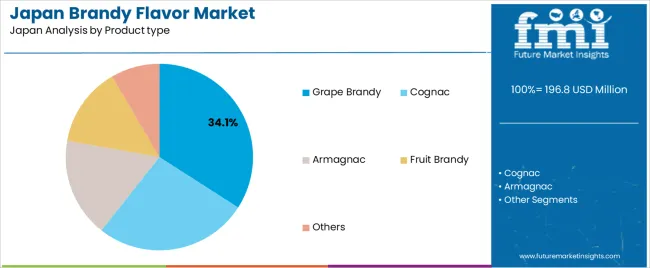
Grape brandy is the dominant product type for brandy flavor in Japan, accounting for 34.1% of the demand. Grape brandy, which is made from distilled wine, is favored for its smooth, fruity flavor, which complements a wide variety of food applications, from desserts to savory dishes. Its ability to provide depth and enhance the overall flavor profile of food and beverages makes it a popular choice for food manufacturers.
The demand for grape brandy flavor is driven by its versatility and the growing preference for premium, authentic ingredients in culinary applications. Grape brandy’s refined taste, coupled with its ability to pair well with other ingredients, ensures its popularity in both the food and beverage sectors. As Japanese consumers continue to seek high-quality, innovative flavors in their meals and drinks, grape brandy flavor is expected to maintain its leadership in the market.
What Are the Primary Growth Drivers for Brandy Flavor Demand in Japan? Several factors support growth. First, the premiumisation of bakery and confectionery items in Japan drives demand for flavor agents that provide sophistication; brandy flavor fills that role. Second, the growth of low and no alcohol beverage formats encourages usage of flavor systems like brandy without the alcohol content, enabling familiar profiles in mocktails and mixers. Third, Japan’s cocktail culture and mixology revival prompt bars and spirits brands to adopt brandy flavor extracts to innovate new cocktail formats. Finally, clean-label and natural flavor trends favour flavor houses offering aged spirit notes derived from natural extracts rather than synthetic equivalents.
What Are the Key Restraints Affecting Brandy Flavor Demand in Japan? Despite supportive factors, several constraints apply. The cost of premium quality flavoring agents linked to aged spirit profiles is higher, reducing adoption among cost-sensitive brands. Regulatory requirements in Japan concerning flavoring agents and alcohol-derived notes increase formulation complexity and may restrict some uses. Consumer familiarity with other flavor profiles, such as whisky or rum notes, may limit uptake of brandy flavor variations in certain segments. Additionally, product developers must ensure that brandy flavor aligns with local taste preferences. Japanese consumers often favour subtle and refined profiles rather than bold spirit-like notes, which can raise development challenges.
What Are the Key Trends Shaping Brandy Flavor Demand in Japan? Key trends include the expansion of brandy flavor into categories beyond spirits, such as desserts, bakery goods, sauces and functional beverages, broadening the application base. Another trend is the development of natural and alcohol-free brandy flavor extracts, enabling usage in non-alcoholic formats and clean-label products. Food flavor suppliers are offering micro-encapsulated brandy flavor systems that improve aroma retention and enable more flexible processing in Japanese manufacturing environments. Finally, co-creation of flavor systems tailored for Japanese palates, such as combining brandy notes with traditional local ingredients, supports differentiated product launches and niche positioning.
The demand for brandy flavor in Japan shows varying growth rates across different regions, with Kyushu & Okinawa leading at a CAGR of 3.9%. Kanto follows closely with a 3.6% CAGR, driven by strong consumer interest in premium and flavored spirits. The Kinki region shows a slightly slower growth rate of 3.2%, while Chubu, Tohoku, and the Rest of Japan exhibit even more modest growth, with respective CAGRs of 2.8%, 2.5%, and 2.3%. These regional differences reflect varying levels of consumer demand, preferences for traditional vs. innovative flavors, and the varying presence of spirits markets across Japan.
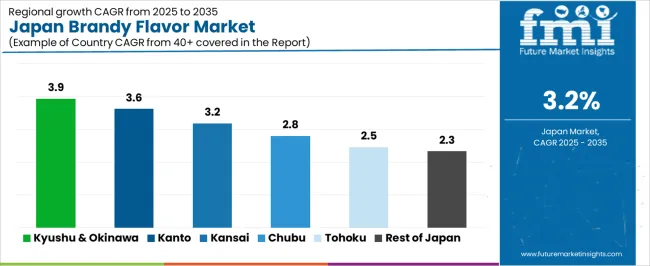
| Region | CAGR (2025-2035) |
|---|---|
| Kyushu & Okinawa | 3.9% |
| Kanto | 3.6% |
| Kinki | 3.2% |
| Chubu | 2.8% |
| Tohoku | 2.5% |
| Rest of Japan | 2.3% |
The demand for brandy flavor in Kyushu & Okinawa is projected to grow at a CAGR of 3.9%, driven by the region's growing interest in flavored spirits and premium beverages. Kyushu & Okinawa have strong ties to the liquor industry, particularly with the production of local spirits such as shochu. However, the region is also increasingly adopting global trends, including a growing interest in western-style spirits like brandy. The younger demographic, who are more willing to explore new flavors and unique combinations, is a significant driver for the demand in this region.
The ongoing shift toward a more diverse range of alcoholic beverages, coupled with the popularity of flavored drinks in both casual and upscale settings, is pushing the demand for brandy-flavored products. Additionally, as the tourism industry continues to thrive in Okinawa, it further supports the region's growing acceptance of diverse and international beverage options.
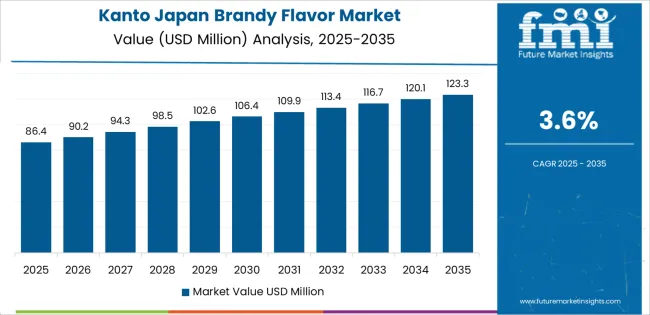
In the Kanto region, the demand for brandy flavor is expected to grow at a CAGR of 3.6%, fueled by its large, diverse population and vibrant consumer culture. As the economic and cultural hub of Japan, Kanto, particularly Tokyo, is a hotspot for new trends in food and beverage consumption. The region has seen a steady increase in consumer interest in premium spirits, including brandy, as well as innovative cocktails that feature brandy flavor.
The rising demand for flavored spirits can be attributed to a shift towards more sophisticated and varied drinking experiences, driven by younger generations seeking new and exciting options. Furthermore, the Kanto region’s robust hospitality sector, which includes high-end bars and restaurants, encourages the consumption of branded, flavorful drinks. This increasing sophistication in the market, along with the region's broader embrace of global beverage trends, ensures a strong demand for brandy-flavored products.
The demand for brandy flavor in the Kinki region is projected to grow at a CAGR of 3.2%, reflecting the region’s appreciation for both traditional and modern alcoholic beverages. Kinki, which includes Osaka and Kyoto, is known for its rich food and beverage culture, and there is a growing interest in premium spirits like brandy. This region's consumers have a strong appreciation for quality, and as the demand for more refined drinking experiences increases, brandy flavor has found its niche in both traditional and contemporary settings.
However, the growth rate is somewhat slower compared to other regions, likely due to a more conservative approach to adopting new alcohol trends. Despite this, the rising number of bars, restaurants, and cafes offering creative cocktails and a wider range of spirits is contributing to the steady increase in brandy flavor demand. Additionally, the presence of international influences in cities like Osaka helps introduce diverse drinking experiences to local consumers.
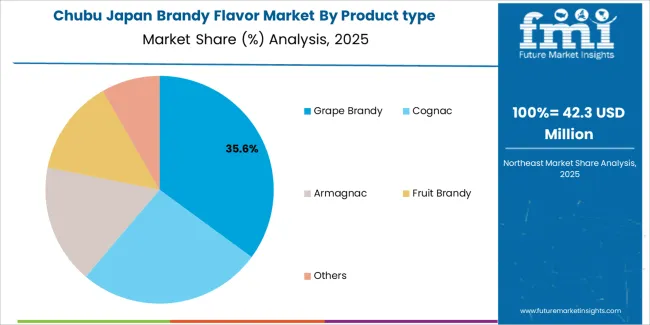
The demand for brandy flavor in Chubu is expected to grow at a CAGR of 2.8%, reflecting the region's steady, yet slower adoption of flavored spirits. Chubu is home to several large manufacturing cities, and while its alcoholic beverage market is significant, it tends to favor more traditional spirits like sake and shochu. However, there is a growing trend of innovation in the food and beverage industry, and consumers in Chubu are increasingly seeking out new and unique flavors, including brandy.
The demand for brandy flavor is rising as younger generations, in particular, are drawn to international spirits and cocktail trends. The slower growth rate in this region may be due to a preference for more familiar, locally produced alcoholic beverages, but as consumer preferences continue to evolve, brandy flavor is expected to experience gradual growth.
In Tohoku, the demand for brandy flavor is projected to grow at a CAGR of 2.5%, reflecting a more cautious and traditional approach to alcoholic beverages. The Tohoku region has a strong cultural affinity for local spirits such as sake and shochu, and the introduction of western spirits like brandy is a more recent development. While there is growing awareness of global alcohol trends, Tohoku's demand for brandy flavor remains modest compared to other regions.
The slower growth rate may be attributed to the region's more conservative population and a greater preference for traditional drinks. However, as younger generations and urban areas within Tohoku become more receptive to new flavors and trends, demand for brandy-flavored beverages is expected to see steady, incremental growth.
In the Rest of Japan, the demand for brandy flavor is projected to grow at a CAGR of 2.3%, indicating a relatively slower but steady adoption across less urbanized areas. The Rest of Japan, including rural and suburban areas, traditionally has a stronger preference for local alcoholic beverages such as sake and shochu. However, as the influence of global beverage trends continues to spread, more consumers in these areas are beginning to experiment with foreign flavors like brandy.
The growth in demand for brandy flavor is expected to be driven by an increasing awareness of international alcohol trends and the gradual introduction of premium spirits into these regions. Although the growth rate is slower, the evolving interest in new drinking experiences ensures that brandy flavor will continue to experience modest but consistent demand throughout the rest of Japan.

Demand for brandy flavor solutions in Japan is increasing as food, beverage, and cocktail mixing sectors seek richer spirit inspired profiles. The global brandy flavor market is projected to grow significantly, with natural brandy flavors making up a significant portion of the market share. The Japan specific market for brandy and brandy flavored products is also expanding, driven by evolving consumer tastes and increasing interest in premium flavors. Leading flavor houses in this industry include Givaudan SA (holding approximately 21% market share), Firmenich SA, International Flavors & Fragrances Inc. (IFF), Symrise AG, and Mane SA. These companies provide brandy flavor systems for a range of products in the Japanese market, including beverages, confectionery, and bakery goods.
Competition in the industry is shaped by factors such as flavor authenticity, formulation flexibility, and regulatory compliance. Companies develop brandy flavor systems that replicate aged spirit notes like oak, caramel, and vanilla, which are used in both alcoholic and non-alcoholic applications. Another area of competition is clean-label solutions, as Japanese manufacturers increasingly prefer natural ingredients and minimal additives. Additionally, companies focus on creating heat stable formats and encapsulation technologies to ensure flavor retention during processing. Marketing materials typically emphasize flavor accuracy, regulatory compliance for Japan, and versatility across different product categories. By aligning their offerings with Japan's evolving food and beverage trends, these companies aim to expand their presence in the brandy flavor segment.
| Items | Details |
|---|---|
| Quantitative Units | USD Million |
| Regions Covered | Japan |
| Application | Bakery & Confectionery, Meat & Poultry, Seafood, Sauces & Savory, Desserts & Frozen Food |
| Product Type | Grape Brandy, Cognac, Armagnac, Fruit Brandy, Others |
| Distribution Channel | B2B (Direct Sales), B2C (Indirect Sales), Store-based Retailing, Supermarket/Hypermarket, Convenience Stores |
| Key Companies Profiled | Givaudan SA, Firmenich SA, International Flavors & Fragrances Inc. (IFF), Symrise AG, Mane SA |
| Additional Attributes | The market analysis includes dollar sales by application, product type, distribution channel, and company categories. It also covers regional demand trends in Japan, particularly driven by the growing use of brandy flavors in food and beverage products, including bakery, confectionery, and savory items. The competitive landscape highlights key manufacturers focusing on innovations in flavor formulations for various culinary applications. Trends in the increasing demand for premium brandy flavors like Cognac and Armagnac, as well as the rising popularity of flavored sauces and desserts, are explored, along with advancements in flavor extraction and application technologies. |
The demand for brandy flavor in japan is estimated to be valued at USD 196.8 million in 2025.
The market size for the brandy flavor in japan is projected to reach USD 268.4 million by 2035.
The demand for brandy flavor in japan is expected to grow at a 3.2% CAGR between 2025 and 2035.
The key product types in brandy flavor in japan are bakery & confectionery, meat & poultry, seafood, sauces & savory and desserts & frozen food.
In terms of product type, grape brandy segment is expected to command 34.1% share in the brandy flavor in japan in 2025.






Our Research Products

The "Full Research Suite" delivers actionable market intel, deep dives on markets or technologies, so clients act faster, cut risk, and unlock growth.

The Leaderboard benchmarks and ranks top vendors, classifying them as Established Leaders, Leading Challengers, or Disruptors & Challengers.

Locates where complements amplify value and substitutes erode it, forecasting net impact by horizon

We deliver granular, decision-grade intel: market sizing, 5-year forecasts, pricing, adoption, usage, revenue, and operational KPIs—plus competitor tracking, regulation, and value chains—across 60 countries broadly.

Spot the shifts before they hit your P&L. We track inflection points, adoption curves, pricing moves, and ecosystem plays to show where demand is heading, why it is changing, and what to do next across high-growth markets and disruptive tech

Real-time reads of user behavior. We track shifting priorities, perceptions of today’s and next-gen services, and provider experience, then pace how fast tech moves from trial to adoption, blending buyer, consumer, and channel inputs with social signals (#WhySwitch, #UX).

Partner with our analyst team to build a custom report designed around your business priorities. From analysing market trends to assessing competitors or crafting bespoke datasets, we tailor insights to your needs.
Supplier Intelligence
Discovery & Profiling
Capacity & Footprint
Performance & Risk
Compliance & Governance
Commercial Readiness
Who Supplies Whom
Scorecards & Shortlists
Playbooks & Docs
Category Intelligence
Definition & Scope
Demand & Use Cases
Cost Drivers
Market Structure
Supply Chain Map
Trade & Policy
Operating Norms
Deliverables
Buyer Intelligence
Account Basics
Spend & Scope
Procurement Model
Vendor Requirements
Terms & Policies
Entry Strategy
Pain Points & Triggers
Outputs
Pricing Analysis
Benchmarks
Trends
Should-Cost
Indexation
Landed Cost
Commercial Terms
Deliverables
Brand Analysis
Positioning & Value Prop
Share & Presence
Customer Evidence
Go-to-Market
Digital & Reputation
Compliance & Trust
KPIs & Gaps
Outputs
Full Research Suite comprises of:
Market outlook & trends analysis
Interviews & case studies
Strategic recommendations
Vendor profiles & capabilities analysis
5-year forecasts
8 regions and 60+ country-level data splits
Market segment data splits
12 months of continuous data updates
DELIVERED AS:
PDF EXCEL ONLINE
Brandy Flavor Market Size, Growth, and Forecast for 2025 to 2035
Japan Faith-based Tourism Market Size and Share Forecast Outlook 2025 to 2035
Japan Sports Tourism Market Size and Share Forecast Outlook 2025 to 2035
Flavor Modulator Market Size and Share Forecast Outlook 2025 to 2035
Japan Respiratory Inhaler Devices Market Size and Share Forecast Outlook 2025 to 2035
Japan Halal Tourism Market Size and Share Forecast Outlook 2025 to 2035
Flavor Emulsions Market Size and Share Forecast Outlook 2025 to 2035
Flavor Masking Agents Market Size and Share Forecast Outlook 2025 to 2035
Flavor Modulators Market Size and Share Forecast Outlook 2025 to 2035
Flavor Compounds Market Size and Share Forecast Outlook 2025 to 2035
Japan Automated People Mover Industry Size and Share Forecast Outlook 2025 to 2035
Flavoring Cosmetic Formulation Agents Market Size and Share Forecast Outlook 2025 to 2035
Japan Automotive Load Floor Industry Analysis Size and Share Forecast Outlook 2025 to 2035
Flavored Whiskey Market Size and Share Forecast Outlook 2025 to 2035
Flavored Butter And Oils Market Size and Share Forecast Outlook 2025 to 2035
Japan Food Cling Film Market Size and Share Forecast Outlook 2025 to 2035
Japan Polypropylene Packaging Films Market Size and Share Forecast Outlook 2025 to 2035
Flavoring Oils Market Size and Share Forecast Outlook 2025 to 2035
Flavoring Agents Market Size and Share Forecast Outlook 2025 to 2035
Flavors for Pharmaceutical & Healthcare Applications Market Size and Share Forecast Outlook 2025 to 2035

Thank you!
You will receive an email from our Business Development Manager. Please be sure to check your SPAM/JUNK folder too.
Chat With
MaRIA